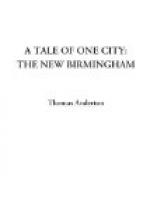Indeed, until recent years, the leading authorities of the town were anything but enterprising, and their view of future possibilities very limited. Could they have seen a little farther ahead they might have laid out money to the great profit and future advantage of the community. They could have erected new corporation offices and municipal buildings before land in the centre of the town became so very costly; the gas and water interests might have been purchased, probably at a price that would have saved the town thousands of pounds. It is also understood that they might have purchased Aston Hall, with its 170 acres close to the town, on terms which would have made the land (now nearly all built upon) a veritable Tom Tidler’s ground for the town and corporation. But our shopkeeper senators would have nothing to do with such bold and far-reaching schemes, and were given to opposing them when suggested by men more courageous and far-seeing than themselves.
Between twenty-five and thirty years ago it was felt by the more advanced and intelligent portion of the community that the time had come for the town to arouse itself, and that certain reforms should no longer be delayed. It was beginning to be felt that the Town Council did not fairly represent the advancing aspirations and the growing needs, importance, and wealth of the town. Sanitary reforms were required, the growing traffic in the principal streets called for better and more durable roadways, and Macadamised and granite paved streets no longer answered the purposes required. The latter were heavy, noisy, and lumbering; the former were not sufficiently durable. Moreover, “Macadam” consisted of sharply-cut pieces of metal put upon the streets, which were left for cart and carriage wheels to break up and press down into something like a level surface. When this was done it made objectionable dust in dry weather, and in wet weather it converted the streets into avenues of mud and puddle to be scraped up, or to be swept off, by some curiously-devised machine carts constructed for the purpose. Carriage people, I fear, often cursed the stone stuff they had to grind into the roads, and pedestrians anathematized the mud and the dust.
As many people will remember, in some of the less important streets the footways were paved with what were called “petrified kidneys”—stones about as big as a good-sized potato, very durable but extremely unpleasant to walk upon. Little or nothing was done to improve the slummy and dirty parts of the town, or to remove some of those foul courts and alleys which were not only disgraceful in appearance but were a menace to the health of the inhabitants.
In fact, for one reason or another, the authorities left undone the things they ought to have done, and possibly they did some things they ought not to have done, and if allowed to go on it is probable there would soon have been no health in us. It may, however, be admitted that Birmingham was no worse governed than many other large towns in the comparatively unprogressive days of which I speak, but a new race of more advanced and energetic men were dissatisfied with the sluggish, stagnant state of local government, and they felt that the hour had struck for the inauguration of some large and important improvements. Such was the state of affairs about the year 1868.




